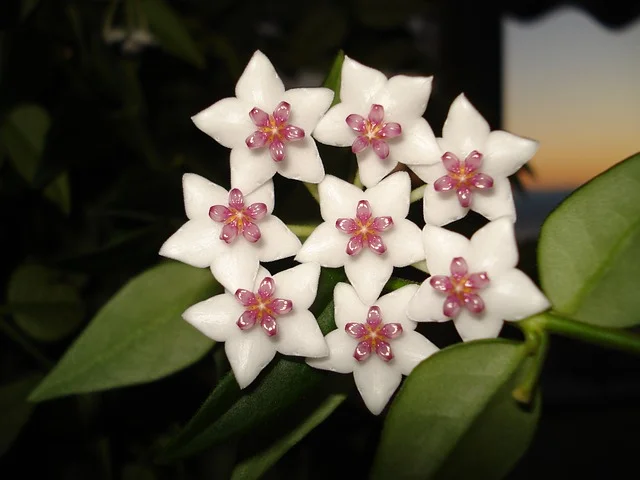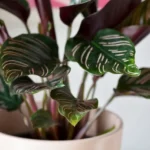Table of Contents
The Care And Growth Of The Hindu Rope Plant
The Hindu rope plant, also known as Hoya, is a type of vine that grows beautiful star-shaped flowers with a waxy texture.
These succulents are sometimes called Krinkle Kurl because the leaves, which may be oval or heart-shaped, grow to twist, turn, and curl.
The vines and leaves develop and twist, eventually forming a rope-like structure, and producing the flower clusters.
As long as there is plenty of light and only a small amount of water, these lovely hoya plants are easy to care for. The simplicity of the care, as well as the appearance of the mature plant, often makes it a nice choice for a houseplant.
The genus includes between 200 and 300 species. These are tropical plants in the dogbane family, called Apocynaceae.
The majority of these plants are from Asian countries like Bangladesh, India, Indonesia, Malaysia, New Guinea, the Philippines, Polynesia, Thailand, and Vietnam. However, there are some species found in Australia as well.
These plants are slow-growing. It may take several years for the rope plant to develop the star-shaped waxy flowers it is known for.
When these clusters are produced, they normally form in the spring and early summer months, and their beauty is worth the wait.
The flowers vary based on species, but they may grow to be white, pink, burgundy, yellow, orange, and almost black. Of course, the aroma is quite distinctive as well, being very similar to that of mocha.
Propagation
The propagation of Hindu rope plants is typically started by cutting the stem tips. Each tip needs to include at least one pair of leaves and should be between two and three inches long. Propagation works best if the tips are cut from a healthy, vibrant plant.
Cuttings quickly develop roots when they are in damp sand or water. Only the bare stem of the cutting should be in the water.
It is recommended that the leaves remain above the surface of the liquid. When the roots start to show, the houseplant can be transferred into a small pot, equipped with excellent drainage.
Required Care
The Hindu rope plant is easy to care for, but there are still some requirements for it to develop into something healthy and beautiful.
When these basic needs are fulfilled, the hoya can grow up to 15 inches long and produce many beautiful flower clusters.
Light
Hindu rope plants require bright but indirect light. Such plants grow better when they have southern exposure, but they can adapt to the light coming from the east or west as well.
It is essential that these lighting requirements are fulfilled. In low lighting, the plant may never bloom, but direct sunlight can burn the leaves.
If the leaves start to lose their color, moving the plant to slightly lower lighting may help.
Water
These succulents require little water. Moisture may be added when the soil is almost dry. More frequent watering is needed during the warmer months. In winter, hardly any water may be needed at all.
Humidity
Regular household humidity levels of between 30-40% are fine. However, these plants grow and thrive more when the level is at about 60%.
To increase humidity, if and when needed, a fine mist may be sprayed into the air around the succulent. An air humidifier can help as well.
Temperature
The best daytime temperature for the hoya plant is around 21 degrees Celsius (70 degrees Fahrenheit).
The night temperature is optimal between 15 and 18 degrees Celsius (60-65 degrees Fahrenheit).
Soil
Because it is easy to overwater a Hindu rope plant, well-aerated quick-draining soil is required. Heavier soil should be made lighter by adding some sand.
It is also recommended that each houseplant is contained in a small pot for this same reason.
Fertilizer: A half-strength water-soluble fertilizer, high in potassium, is suggested. During the spring and summer, this fertilizer should be added to the soil once a month.
Pruning
Pruning can be done to these hoya plants to scale back their size or reinvigorate the leaves and flowers. It can be completed for propagation as well.
Cutting tips and stems with pruning shears or a sharp blade is recommended. Old stems are never to be cut off in their entirety because this is where the flowers develop.
Leafless stubs and spurs may appear over time. These pieces are crucial to developing new flowers and should not be removed. Dead flowers and stalks can remain in place if the caregiver wants even more flowers to develop.
Extra Tips For Hindu Rope Plant Care
Pests and Diseases
The most common pest to this succulent is the mealybug. These creatures easily find their way in between the twists and curls of the leaves.
Signs that the insects are present include a waxy or cotton-like substance forming on the leaves or other areas where the pests have settled.
Mealybugs may be eliminated by spraying the plant with the appropriate solution as well as insecticidal soap.
Care must be taken that any infestations are completely eliminated. Checking the leaves, flowers, and roots for these insects on a regular basis is advised.
The most common disease that this plant develops is botrytis. This is a fungus that produces gray moldy areas on the leaves.
To treat this issue, trim off any dead or dying leaves and flowers. Prevent water from touching infected areas, and ensure there is good air circulation. The fungus may be treated with fungicide or a baking soda mixture.
Another common disease is stem and root rot. This causes leaves to turn yellow and wilt. There may also be a dark discoloration on the stem starting from the roots.
This condition is often caused by overwatering. To remedy the problem, infected roots can be cut just above the point where the rot starts.
This is at the point where they are light-colored and firm. The plant should be sterilized to prevent the rot from spreading. A fungicide may be required to treat the rot, depending on the severity.
Toxicity
The Hindu rope plant is not toxic to people or animals. However, if large amounts of the plant are consumed, pets can become ill.
If this is a concern, potted plants can be placed in hanging containers and baskets out of reach.
Image by Christiane M. from Pixabay


